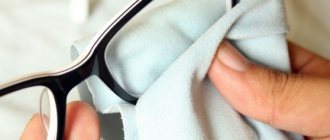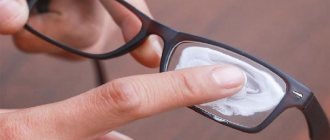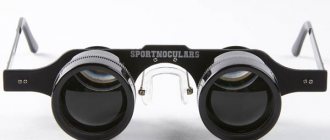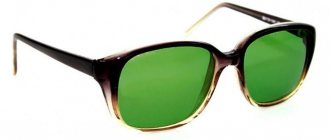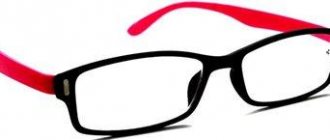Even with the most careful handling, glasses will develop scratches. They can be almost invisible or, on the contrary, quite large. Glasses not only lose their attractive appearance, but also cease to be beneficial for the eyes. Ophthalmologists do not recommend wearing glasses with defects: scratches impair vision and can lead to systematic headaches.
Share
Tweet
Share
Cool
Send
Causes of scratches
Scratches occur both during active use of the item and during storage (in a pocket or bag). Damage occurs due to dust particles settling on the glass. When a person wipes their lenses, these grains leave behind traces.
Less common causes of scratches include:
- friction on hard surfaces;
- poor care;
- accidental fall;
- weather factors;
- improper storage;
- frequent wiping with a napkin.
Glasses have a wide range of applications: sun protection, vision correction, creating a business image. Cheap models are often simply thrown away and replaced with similar ones. But for glasses specially made to order, this option is definitely not suitable.
You need to clean your lenses at least once a day. It's best to do this in the morning. Over the course of a day, a lot of dust and residue from protein reflections accumulate on glasses. If you limit yourself to the edge of the hem or sleeve, this will contribute to the appearance of new scratches (albeit not always noticeable).
Gradually, the optical capabilities of the glasses decrease. You have to strain your eyes, they become red. The signal of fatigue enters the brain, and from there it is transmitted throughout the body.
Clear nail polish
If you are a woman, then applying nail polish will be an easy task for you, but if you are a man, then you will finally understand the complexity of this process.
This method of removing scratches requires care and precision. Here's what you need to do: Gently dip the edge of a wooden toothpick into the polish and then apply it to the lenses. Your hand must be steady so as not to stain the frame.
You also need to keep in mind that you don't need a thick varnish, otherwise it will dry before you evenly distribute it over the surface. Do not touch the lenses until the polish is completely dry.
Differences in polishing small, deep, extensive scratches
The glasses are carefully inspected to determine the extent of damage. It's easy to remove tiny abrasions yourself using a soft polishing cloth. Soap or toothpaste will be good helpers. With regular sanding, minor scratches will quickly disappear.
In case of deep damage, more serious actions are required: it is necessary to remove the surface layer of glass. Here you cannot do without special equipment. The polishing method depends on the material used to make the glasses. It is much easier to remove scratches from plastic lenses than from glass ones.
Dentifrice
If you are more used to using toothpaste, then most likely you do not keep toothpowder at home. But when you learn about its benefits for glasses (and teeth), you may change your mind.
How in the old days our great-grandmothers went to bed on Epiphany and the next morning they knew the future
Grated pie with jam: how to prepare your favorite childhood dessert
I serve a budget-friendly, and most importantly healthy, side dish to the table: I take carrots and onions
All you need to do is simply dilute a little powder in a little water and stir it to a paste consistency. Apply the mixture to the damaged lenses and wait about 20 minutes.
Using a microfiber cloth, carefully remove any remaining paste and enjoy the result.
How to clean glass lenses?
High-quality glass is quite resistant to external influences of a physical nature. They are durable. One of the disadvantages is the large weight: the diopters make the glass massive. It is difficult to remove scratches from glass glasses: not every composition can remove them from a hard surface.
If there is no special cleaning liquid and you need to remove dust from the glass, dishwashing gel and a soft cotton cloth will do. The material must be perfectly clean, otherwise damage will remain on the surface of the glass.
Soda
A liquid slurry is prepared from soda and water. The resulting composition is applied to a cotton pad and the lenses are treated with circular movements. The glasses are then rinsed with plenty of water. If necessary, the procedure must be repeated.
Paste GOI
GOI paste is a technical composition created for polishing optical glasses. It is also suitable for regular glasses. Before use, it is better to remove the lenses from the frame.
- The paste is applied to the felt cloth and the lens is placed on top.
- The glasses are rotated on the felt: this is how the lenses are polished.
- Remove any remaining mixture from the surface with a clean cloth.
- You don’t have to remove the lenses from the frame, but then you will have to act very carefully: the paste should not get on other elements of the glasses.
GOI paste is used not only for manual processing, but also for mechanical processing. The composition is rubbed in using a grinding machine at minimum speed. At high temperatures the glass will crack. A shaving machine is also suitable: the knives are replaced with a microfiber cloth.
Toothpaste
The substances included in the paste gently polish the outer layer of the lens, thereby eliminating unnecessary defects.
- A small amount of the product should be applied to the glass and rubbed over the entire surface with a soft cloth.
- It is important to do this as quickly as possible: the paste dries in a matter of seconds.
- The composition is washed off from the surface of the glasses after a few minutes.
- The final stage is to wipe the lenses dry. The main thing is that there are no traces left.
Dentifrice
The powder is mixed with water until a paste forms. The mixture is applied to the damaged surface and wait until it is completely dry. The dried crust is carefully removed. If you rush, you can ruin your glasses even more. The lenses are polished and rinsed.
Wood or glass polish
If the polish contains wax, it will easily cope with scratches on the lenses. First, wash the glasses thoroughly with dish soap and allow them to dry. The polish is applied to the glass and rubbed in with a soft cloth. The wax will fill the scratches and slow down the spread of cracks. The procedure can be repeated until the desired result is obtained.
CD polish
The composition is available in computer stores. It differs from household cleaning products in its careful treatment of cleaning surfaces. The main task of the disc compound is to eliminate minor damage. Lenses are processed according to the same principle.
Auto glass washer
Windshield washer solution is sold in any store (even large grocery chains). The composition was originally created not only for washing off liquids, but also for smoothing out small cracks on the surface. Moreover, this is a way to protect lenses from fog and dust. A small amount of washer is applied to the glasses and rubbed in a circular motion until all damage is completely removed.
Nail polish
Colorless varnish, like wax, fills all unevenness and forms a protective layer. You need to work with it with pinpoint precision: the composition dries quickly. To mask defects, use a wooden toothpick. It is dipped into the bottle and the tip is drawn along the surface of the lens. Only high-quality varnish is suitable for the job; it should not be thick or expired.
Car wax
Wax intended for polishing the car body is used for deep and large damage. Car polish is applied to the glass with a flannel rag. The wax must be rubbed in until the scratches disappear completely. At the final stage, the surface is wiped with a clean, lint-free cloth. Don't worry if you put more wax on your lens than required. Excess can be easily removed with a soft cloth.
Abrasive gel for glasses
This professional product is used to remove the top layer of lenses. If there is a shading cover, you will have to forget about it. The gel is suitable for caring for any type of goggles (including swimming goggles). When working, use protective latex gloves. The gel is applied to the damaged surface according to the instructions. Then the lenses are wiped with an alcohol wipe.
Alcohol
Alcohol does an excellent job of cleaning in combination with baking soda. This mixture instantly restores the condition of the lenses and eliminates damage. Residues from the surface can be easily washed off with running water. For minor damage, medical alcohol will be a lifesaver.
Water repellent spray
The lenses have a water-repellent layer: as a rule, it is the final layer. Therefore, a water-repellent spray can save your glasses from scratches. It is commonly used by motorists to protect their windshield. The spray is simply applied to the glasses and then wiped with a dry cloth. In addition, the composition can be used to prevent fogging.
Vaseline and wood varnish
Transparent wood varnish is best purchased in spray form. A large selection is available in construction stores. A small amount of varnish is applied to the lenses and then treated with Vaseline. The amount of Vaseline is as needed. Remove any residue with a dry, clean cloth, making sure there are no cracks left.
Helpful information
Tips for removing scratches from glasses:
For processing, you can only use a soft cloth that does not leave lint behind.
It can be suede, felt, flannel, or a cotton pad. It’s good if you have special wipes on hand for cleaning your optics.- The use of abrasive compounds is prohibited.
- If there is any doubt about what result will be obtained after treatment, first you need to try the product on another product made of a similar material.
- During polishing, only the outer side of the glasses is processed. After completion, wipe them with a clean cloth so that any remaining product does not get into the eyes and cause irritation.
If you are interested in how to remove small and deep scratches from various surfaces and objects, take a look at this section.
Features of grinding plastic lenses
Plastic lenses are becoming increasingly popular today. People prefer to buy such glasses because they are light and comfortable to wear. But if the operating rules are violated, they are easily damaged: cracks, scratches, and rainbow stains appear. Lenses should not be cleaned with caustic chemicals or solutions to remove greasy deposits.
Plastic can and should even be washed regularly with warm water and soap. At the optical store, you should purchase special compounds and wipes for cleaning lenses. They are not capable of damaging the surface and boast an antistatic effect. It is important that dust, grease and particles of aggressive compounds do not get on the glasses.
Disadvantages of DIY Cleaning
If no method gives the desired result, it is better to leave amateur efforts to save glasses and entrust this matter to professionals. They will polish the lenses using special equipment. Polishing at home has a number of disadvantages. Traditional methods only deal with “hair” scratches. In more severe situations, there is a risk of depressions forming at the cleaning site, causing optical distortions.
Expert opinion
Danilova Elena Fedorovna
Ophthalmologist of the highest qualification category, Doctor of Medical Sciences. Has extensive experience in diagnosing and treating eye diseases in adults and children.
Attempts to remove scratches on your own are often ineffective. The surface of the lenses is too sensitive: it becomes damaged and becomes cloudy. Chemical particles easily scratch not only glass, but also plastic. And a soda solution can lead to persistent plaque and a decrease in transparency.
Doctors believe that removing scratches on lenses yourself only guarantees a cosmetic effect. Despite their excellent appearance, their optical properties may be damaged.
After self-cleaning, the special coating, which is antistatic and water-repellent, is sometimes washed off. During polishing, at least a microscopic part of the material is removed, which violates the geometry of the refractive surface. This may lead to picture distortion.
Glass washer
Automotive glass cleaner was made specifically to smooth out the tiny cracks and scratches that form on car windows. In addition, this product will not only save the lenses from scratches, but will also allow them to fog up much less often.
Simply apply a small amount of glass cleaner to the lenses and wipe them in a circular motion using a cloth. The effect will be noticeable instantly. Who would have thought that this liquid might someday be needed to clean glasses. And, by the way, it is completely safe.
The Ministry of Digital Development plans to conduct an experiment with driver's licenses
80 minutes in which you can collect the strongest Epiphany water from January 18 to 19
Is it possible to detect deception by handwriting?

